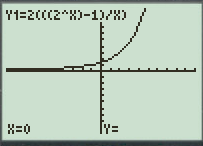
Concept explainers
(a)
To find: The difference quotient
(a)
Answer to Problem 46E
The difference quotient
Explanation of Solution
Given information: The function is
Calculation:
Substitute
Substitute
Substitute
Therefore, the difference quotient
(b)
To find: The limit of difference quotient in part (a) as
(b)
Answer to Problem 46E
The limit of difference quotient in part (a) as
Explanation of Solution
Given information: The function is
Calculation:
As calculated in part(a), the difference quotient function is equal to
Check the limit of difference quotient as
To graph a function
First press “ON” button on graphical calculator, press
The display will show the equation,
Now, press the

Figure (1)
As observed from graph, the function
Now check the limit by table.
To make the table of function
First press “ON” button on graphical calculator, press
First set the Table setup, Enter the keystrokes
Now draw the table, Enter the keystrokes

Figure (2)
As observed from table the value of
Therefore, the limit of difference quotient in part (a) as
(c)
To find: The difference between the value
(c)
Answer to Problem 46E
The difference between the value
Explanation of Solution
Given information: The function is
Calculation:
As calculated in part (b), the limit of difference quotient function as
Check the difference between
Therefore, the difference between the value
(d)
To check: The graph of
(d)
Answer to Problem 46E
Yes, the graph of
Explanation of Solution
Given information: The function is
Calculation:
The formula for the slope of the function
As calculated in part (b), the limit of difference quotient function as
Therefore, the graph of
Chapter 2 Solutions
Calculus 2012 Student Edition (by Finney/Demana/Waits/Kennedy)
Additional Math Textbook Solutions
Calculus, Single Variable: Early Transcendentals (3rd Edition)
Calculus & Its Applications (14th Edition)
Calculus: Early Transcendentals (2nd Edition)
Calculus and Its Applications (11th Edition)
Precalculus (10th Edition)
University Calculus: Early Transcendentals (3rd Edition)
 Calculus: Early TranscendentalsCalculusISBN:9781285741550Author:James StewartPublisher:Cengage Learning
Calculus: Early TranscendentalsCalculusISBN:9781285741550Author:James StewartPublisher:Cengage Learning Thomas' Calculus (14th Edition)CalculusISBN:9780134438986Author:Joel R. Hass, Christopher E. Heil, Maurice D. WeirPublisher:PEARSON
Thomas' Calculus (14th Edition)CalculusISBN:9780134438986Author:Joel R. Hass, Christopher E. Heil, Maurice D. WeirPublisher:PEARSON Calculus: Early Transcendentals (3rd Edition)CalculusISBN:9780134763644Author:William L. Briggs, Lyle Cochran, Bernard Gillett, Eric SchulzPublisher:PEARSON
Calculus: Early Transcendentals (3rd Edition)CalculusISBN:9780134763644Author:William L. Briggs, Lyle Cochran, Bernard Gillett, Eric SchulzPublisher:PEARSON Calculus: Early TranscendentalsCalculusISBN:9781319050740Author:Jon Rogawski, Colin Adams, Robert FranzosaPublisher:W. H. Freeman
Calculus: Early TranscendentalsCalculusISBN:9781319050740Author:Jon Rogawski, Colin Adams, Robert FranzosaPublisher:W. H. Freeman
 Calculus: Early Transcendental FunctionsCalculusISBN:9781337552516Author:Ron Larson, Bruce H. EdwardsPublisher:Cengage Learning
Calculus: Early Transcendental FunctionsCalculusISBN:9781337552516Author:Ron Larson, Bruce H. EdwardsPublisher:Cengage Learning





